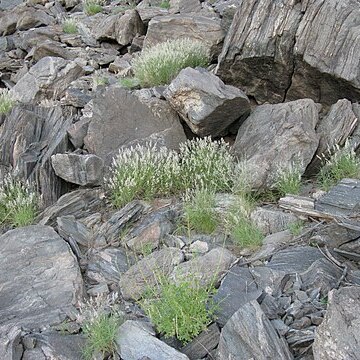Perennial; up to 0.6 m high; compact and densely tufted. Leaf blades 10-250 x 1 mm; leaves markedly basal; often curved; glabrous or with scattered; long; bulbous-based hairs; basal sheaths glabrous or hairy; but not with densely matted woolly hairs. Flowers: inflorescence usually contracted; interrupted; much branched; branches bearing spikelets to near base; spikelets 11-12 mm long; excluding awns; glumes pallid; firm; with membranous apices and margins; glabrous; scabrid; lemma articulation between apex of lemma and base of column; column length variable; scabrid to and at branching point of awns; only central awn plumose; callus 1.5 mm long; with a naked apex varying from pungent to minutely bifid.
Compact and densely tufted; up to 0.6 m high. Leaves markedly basal, often curved, glabrous or with scattered, long, bulbous-based hairs, leaf blades 10-250 mm long, up to 1 mm wide. Basal sheaths glabrous or hairy, but not with densely matted woolly hairs. Spikelets 11-12 mm long (excluding awns). Inflorescence usually contracted, interrupted, much-branched, branches bearing spikelets to near base; glumes pallid, firm, with membranous apices and margins, glabrous, scabrid; lemma articulation between apex of lemma and base of column, column length variable, scabrid to and at branching point of awns; only central awn plumose; callus 1.5 mm long, with a naked tip varying from pungent to minutely bifid.
Compact, densely tufted to 600 mm high; basal sheaths glabrous or hairy, but not with densely matted, woolly hairs; leaves markedly basal, often curved, glabrous or with scattered long bulbous-based hairs. Leaf blade 10-250 x to 1 mm. Inflorescence usually contracted, interrupted; much branched, branches bearing spikelets to near base. Spikelet 11-12 mm long; glumes pallid, firm, apices and margins membranous, glabrous, scabrid; lemma articulation between apex of lemma and base of column; column length variable, scabrid to branching point of awns; only central awn plumose; callus 1.5 mm long, apex naked, varying from pungent to minutely bifid; anther 3.3-4.4 mm long.
Lemma 2-2.5 mm. long, oblong-cylindric, glabrous, smooth in the lower part, slightly scaberulous towards the apex; callus c. 1 mm. long, acute, densely barbate; column 4-10 mm. long, erect or slightly twisted, scaberulous; central awn 2-3 cm. long, scaberulous in the lower part, plumose towards the apex; lateral awns 0.7-1.8 cm. long, delicate, slightly scaberulous.
Panicle 2.5-20 cm. long, very narrow, erect, contracted, but fairly lax and interrupted in the lower part; axis terete, striate, glabrous, smooth in the lower part, scaberulous in the upper; branches solitary, 2-partite nearly from the base, filiform, appressed or the lower suberect, with scaberulous branchlets; axils glabrous.
Compact, densely tufted perennial, up to 0.6 m tall. Leaves basal, linear, rolled, often curved; ligule a fringe of hairs. Inflorescence an interrupted panicle. Spikelets 11-12 mm long (excluding awns), 1-flowered; lemma 3-awned, only central awn plumose, with articulation between apex of lemma and base of column.
Leaf-laminae variable in length, 1.5-25 cm. long, c. 0.5 mm. wide, glaucous, setaceous, convolute, subterete, slightly striate, ending in a very obtuse apex, minutely villous or hirtellous above, glabrous, smooth or finely scaberulous beneath.
Glumes subequal, more or less keeled, finely scaberulous, at least towards the apex; the inferior 8.5-12 mm. long, usually longer than the superior, 3-nerved, obtuse; the superior 8-11 mm. long, 1-3-nerved, subacute.
Compact, densely tufted perennial to 60 cm. Leaves basal, linear, rolled, often curved. Spikelets 11-12 mm long, in an interrupted panicle, central awn plumose, spikelet callus usually bifid.
A herb. It is an erect annual grass. It forms tufts. It can keep growing for a few years. It grows 60 cm high.
Culms erect, slender, simple, glabrous, smooth, 1-noded; nodes dark-coloured, glabrous, smooth.
Perennial, up to 60 cm. high, densely caespitose, with numerous innovations.
Ligule short-ciliate rim; auricles densely barbate; collar glabrous.
Spikelets yellowish, often tinged with purple at the base.
Leaf-sheaths striate, glabrous, smooth.

